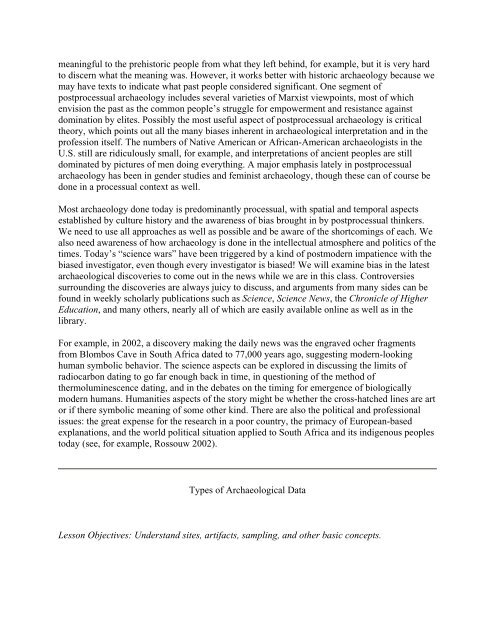INTRODUCTION TO ARCHAEOLOGY Nancy White - Touro Institute
INTRODUCTION TO ARCHAEOLOGY Nancy White - Touro Institute
INTRODUCTION TO ARCHAEOLOGY Nancy White - Touro Institute
Create successful ePaper yourself
Turn your PDF publications into a flip-book with our unique Google optimized e-Paper software.
meaningful to the prehistoric people from what they left behind, for example, but it is very hard<br />
to discern what the meaning was. However, it works better with historic archaeology because we<br />
may have texts to indicate what past people considered significant. One segment of<br />
postprocessual archaeology includes several varieties of Marxist viewpoints, most of which<br />
envision the past as the common people’s struggle for empowerment and resistance against<br />
domination by elites. Possibly the most useful aspect of postprocessual archaeology is critical<br />
theory, which points out all the many biases inherent in archaeological interpretation and in the<br />
profession itself. The numbers of Native American or African-American archaeologists in the<br />
U.S. still are ridiculously small, for example, and interpretations of ancient peoples are still<br />
dominated by pictures of men doing everything. A major emphasis lately in postprocessual<br />
archaeology has been in gender studies and feminist archaeology, though these can of course be<br />
done in a processual context as well.<br />
Most archaeology done today is predominantly processual, with spatial and temporal aspects<br />
established by culture history and the awareness of bias brought in by postprocessual thinkers.<br />
We need to use all approaches as well as possible and be aware of the shortcomings of each. We<br />
also need awareness of how archaeology is done in the intellectual atmosphere and politics of the<br />
times. Today’s “science wars” have been triggered by a kind of postmodern impatience with the<br />
biased investigator, even though every investigator is biased! We will examine bias in the latest<br />
archaeological discoveries to come out in the news while we are in this class. Controversies<br />
surrounding the discoveries are always juicy to discuss, and arguments from many sides can be<br />
found in weekly scholarly publications such as Science, Science News, the Chronicle of Higher<br />
Education, and many others, nearly all of which are easily available online as well as in the<br />
library.<br />
For example, in 2002, a discovery making the daily news was the engraved ocher fragments<br />
from Blombos Cave in South Africa dated to 77,000 years ago, suggesting modern-looking<br />
human symbolic behavior. The science aspects can be explored in discussing the limits of<br />
radiocarbon dating to go far enough back in time, in questioning of the method of<br />
thermoluminescence dating, and in the debates on the timing for emergence of biologically<br />
modern humans. Humanities aspects of the story might be whether the cross-hatched lines are art<br />
or if there symbolic meaning of some other kind. There are also the political and professional<br />
issues: the great expense for the research in a poor country, the primacy of European-based<br />
explanations, and the world political situation applied to South Africa and its indigenous peoples<br />
today (see, for example, Rossouw 2002).<br />
Types of Archaeological Data<br />
Lesson Objectives: Understand sites, artifacts, sampling, and other basic concepts.
















